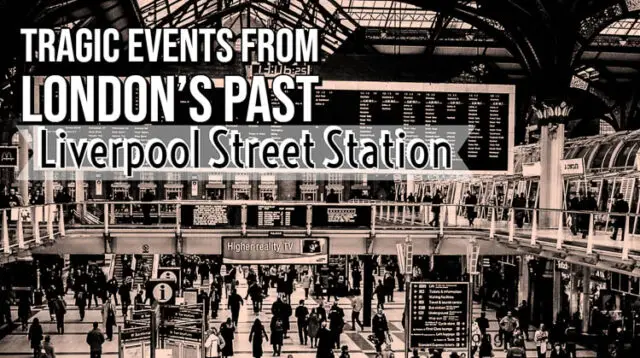The station was first opened in 1874, and over the years, it has undergone various renovations to accommodate the increasing passenger traffic. Liverpool Street Station is located in the City of London, which is the financial district of London. The station is named after the street on which it is located, and it is known for its impressive Victorian architecture.
Liverpool Street Station is the terminus to the end of a journey or the beginning of a new one. Each year 69 million passengers enter and exit the station making it the 3rd busiest station in the country. That is approximately every man, woman, and child in Australia going through the station 3 times a year.
Little do these passengers know they are walking through history on the station concourse where tragedy has struck, more than once. In this blog post, we are going to take a look at some of these haunting tales from the past.
Medieval Moorefields Marsh
Medieval Moorefields Marsh was a wetland area located just outside the walls of the City of London, near what is now Liverpool Street Station. The marsh was formed by the confluence of several small streams and rivers, which made it a natural water source for the surrounding area. However, the marshland was also prone to flooding, especially during high tide, which made it difficult for people to use the area for farming or settlement.
In the 16th century, the City of London began to drain and develop the Moorefields Marsh area to provide more space for urban growth. The construction of Liverpool Street Station in the 19th century further transformed the area, with the marsh being largely replaced by railway tracks and buildings. However, the legacy of the marsh can still be seen in the names of nearby streets such as Moorfields and Marshalsea Road.
Romans walked below the ground of Liverpool Street Station
The first of the Roman roads under Liverpool Street Station is known as the London to Colchester Road. This road was constructed during the reign of Emperor Claudius in AD 43 and was the first road to be built in Britain. It was originally constructed as a military road to facilitate the transportation of troops and supplies between London and Colchester, which was then the capital of Roman Britain. The road was later extended to York and became an important route for trade and commerce.
The second Roman road under Liverpool Street Station is the London to Silchester Road. This road was constructed during the reign of Emperor Nero in AD 60 and connected London with the Roman town of Calleva Atrebatum, now known as Silchester. This road was used to transport goods and people between the two towns and was an important route for the movement of military personnel during the Roman occupation of Britain. Today, parts of the road can still be seen beneath the station, providing a glimpse into the ancient past of this important transport hub.
Bedlam mental asylum
Bedlam Mental Asylum, also known as Bethlem Royal Hospital, is one of the oldest and most infamous mental health institutions in the world. Originally located on the current site of Liverpool St Station. The asylum has a long and dark history that dates back to the 13th century. The hospital was originally founded as a priory for the Order of the Star of Bethlehem, a religious order that specialized in caring for the sick and mentally ill. Over time, the priory evolved into a hospital, and in the 17th century, it became known as Bedlam.
During the 18th and 19th centuries, Bedlam was notorious for its inhumane treatment of patients. Patients were often restrained with chains, and some were subjected to cruel and degrading treatment. Many were left in filthy conditions. The asylum became a popular tourist attraction, with visitors paying a fee to view the “lunatics.” In 1814, the hospital moved to a new location in St. George’s Fields, where it remained until the 1930s.
The original Bedlam Mental Asylum was in operation throughout the English Civil War, Shakespeare, and the Great Fire of London. All beneath the station concourse
Mass Burial site under the station concourse
Plague Victims
Archeologists digging at Liverpool Street station in 2015 uncovered a mass grave of victims from the Plague of London. The site contained 3,000 skeletons in the cemetery that was originally attached to the old Bedlam Mental Asylum. The cemetery was in use between 1559 and the mid-19th century.
During the Great Plague, which lasted from 1665 to 1666, the population of London was hit hard. It is estimated that over 100,000 people died from the disease, which was spread by fleas carried by rats. Due to the sheer number of deaths, mass graves were dug to accommodate the bodies. The site under Liverpool Street station is believed to be one of the many mass graves that were used during this time.
The discovery of the mass grave under Liverpool Street station caused a stir among historians and archaeologists. It was a rare find, and it provided valuable insights into the living conditions of people during the Great Plague. The remains found in the grave were carefully excavated.
Roman Graves below the cemetery
Below the cemetery, archeologists uncovered a Roman road, alongside a Roman cemetery containing approximately 30 bodies.
Demolition of the old Slum ‘The Old Nichol’
The Old Nichol was a notorious slum area located in the East End of London during the late 19th and early 20th centuries. The area was named after the Nichol family, who were wealthy landowners in the area until the 17th century. By the 1800s, the area had become one of the most deprived and overcrowded slums in London. In the 1880s, Old Nichol was dubbed “the worst street in London” by the press due to the extreme poverty, crime, and unsanitary living conditions of its residents. The area was known for its high rates of disease, particularly cholera, typhoid, and tuberculosis. Despite several attempts at improvement, the Old Nichol remained a slum until the early 20th century when it was demolished and replaced with social housing.
One of the most infamous residents of the Old Nichol was Mary Kelly, who was one of the victims of Jack the Ripper. Kelly was a prostitute who lived in Miller’s Court, a small alleyway in the heart of the Old Nichol. Her murder in November 1888 was particularly gruesome, and it is widely believed to be the work of the infamous serial killer who terrorized the streets of Whitechapel that year. Kelly’s death drew attention to the poverty and violence of the Old Nichol, and it is now remembered as one of the most tragic events in the area’s history.
In the 1880s a Royal Commission looked into the problem of poor living conditions, to be followed a decade later with the Housing of the Working Class Act. Councils were forced to provide better homes, and this was the beginning of the end of the slums. The areas around Shoreditch and the arrival of the railways to Liverpool Street station saw the demolition of the Old Nichol, which began in the 1890s. The first phase of the redevelopment involved the clearance of the area around Artillery Lane. The slum had been home to around 5,000 people, many of whom were living in overcrowded and unsanitary conditions.
Today, the Old Nichol is largely forgotten, and little remains of the slum that once defined the area. However, it remains a powerful reminder of the social inequalities and hardships of life in 19th-century London.
Gotha Bombing Raid on Liverpool Street Station: A Tragic Day In The Stations Past
During World War One Germany brought the war to the streets of London.
On the night of 13-14 June 1917, Liverpool Street Station was targeted by a German Gotha bomber during a bombing raid on London by the Luftstreitkräfte. The attack was part of Germany’s campaign of terror bombings on British cities and civilians, which aimed to weaken morale and disrupt the war effort.
The Gotha bomber dropped four bombs on the station, causing significant damage and resulting in the deaths of 162 people. One bomb hit Platform 9, one bomb failed to detonate and the third bomb hit a passenger train that was preparing to depart. The bombs fell on the station’s platforms, causing destruction and chaos. The station was filled with soldiers, many of whom were on leave and returning to the front. The attack was especially devastating for the families and loved ones who had come to say goodbye to the soldiers.
The bombing raid on Liverpool Street Station was just one of many attacks on British cities during the First World War. The Gotha bombers were capable of flying at high altitudes, making them difficult to detect and intercept. The attacks caused widespread fear and panic among the civilian population, as people feared for their safety and the safety of their loved ones.
Despite the devastation caused by the attack, Liverpool Street Station was quickly rebuilt and resumed its role as a key transport hub for London. Today, the station serves as a reminder of the resilience of the British people in the face of adversity, and the sacrifices made by those who fought and died for their country during the First World War.
Liverpool Street Station and the Bishopsgate Bombing
One of the most significant events to occur at Liverpool Street Station in the early 1990s was the Bishopsgate bombing. On April 24, 1993, the Provisional Irish Republican Army (IRA) detonated a large bomb outside the Baltic Exchange building on St. Mary Axe, just a few hundred meters from the station. A telephone warning was sent before the bomb detonated, with the explosion causing significant damage to surrounding buildings, including Liverpool Street Station, which was located just a few hundred meters away. The attack killed one person and injured over 40 others, as well as causing millions of pounds worth of damage.
The bombing had a profound impact on Liverpool Street Station and the surrounding area. The station was forced to close for several days following the attack, disrupting travel across London and the UK. The damaged buildings were eventually demolished and replaced with modern structures, including a new Baltic Exchange building and a skyscraper known as the Gherkin. Liverpool Street Station also underwent extensive renovations in the aftermath of the bombing, including upgrades to its security systems and the addition of new entrances and exits.
Liverpool Street Station and the 7/7 Bombings
On July 7, 2005, Liverpool Street Station became the site of one of the deadliest terrorist attacks in London’s history. Four suicide bombers attacked the London transport system, killing 52 people and injuring more than 700. Three of the bombs exploded on underground trains, and the fourth exploded on a double-decker bus. Liverpool Street Station was directly affected by the bombing because one of the attacks took place on an Eastbound Circle line train 90 meters after leaving Liverpool Street Station. 8 people lost their lives including the bomber on the train.
The bombing at Liverpool Street Station was a tragic event that left an indelible mark on London and its people. The attack was carried out by four extremists who were radicalised to commit terrorism. The terrorists used homemade explosives to carry out the attack, which caused significant damage to the station and surrounding areas. The immediate aftermath of the bombing was chaotic, with emergency services rushing to the scene to help the injured and evacuate the station.






















